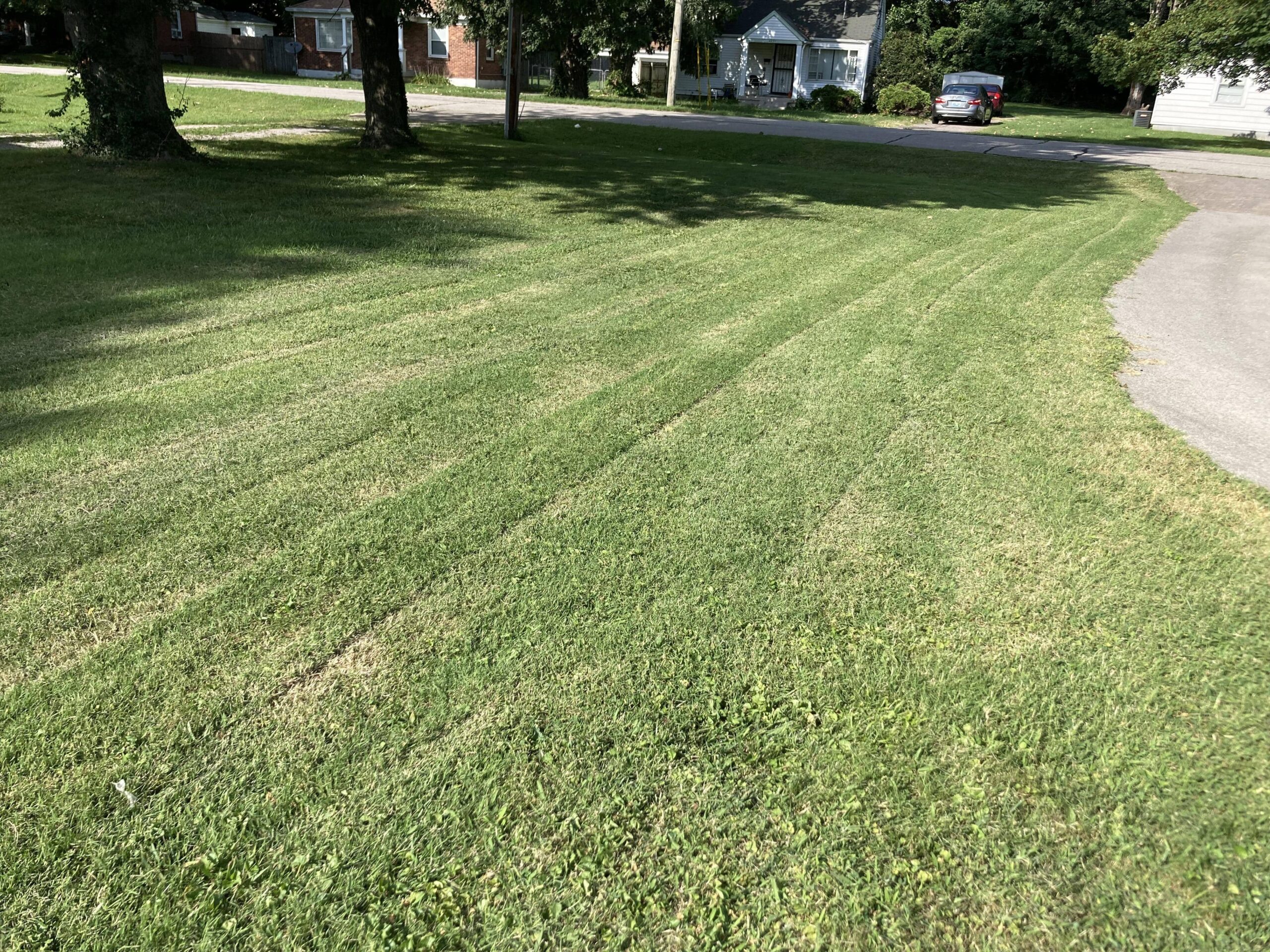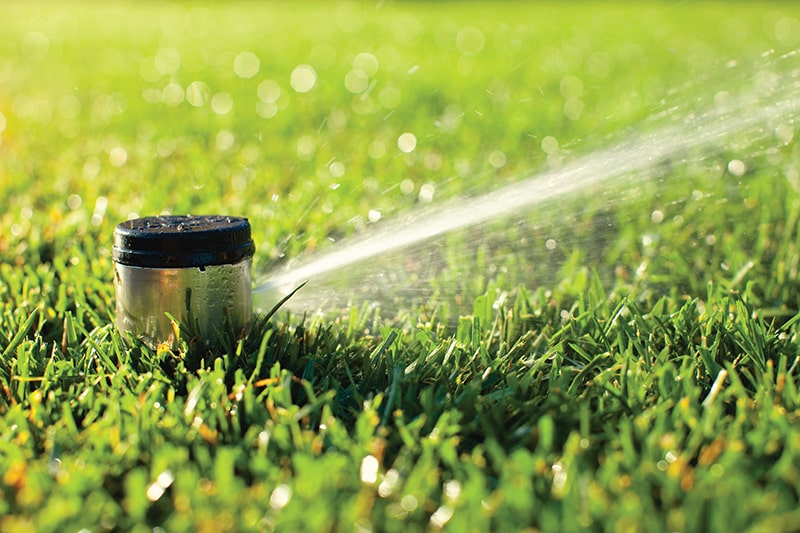To fix a mower that is cutting your lawn unevenly, begin by measuring the height of the cutting deck at each wheel. The deck should be an even distance from the ground at each point. If the deck is uneven, check the wheels. Damaged or unevenly adjusted wheels result in an angled cut when mowing. If the deck height is even but the mower is still not cutting evenly, turn the mower onto its side or upside down. Then, remove any clogs present on the underside of the cutting deck, check the blade for damage, and inspect the crankshaft. Replace any damaged parts, and then get back to mowing your lawn perfectly.
7 Steps to Fix a Lawn Mower that is Cutting Unevenly
If your mower is leaving uneven, ragged grass behind during mowing, it could be caused by a few different issues. First, make sure it isn’t your grass growing unevenly. Then, follow this checklist to correct uneven mowing for both push mowers and riding mowers.
Measure the Deck Height
Begin by parking your mower on a flat, paved surface, such as your driveway. Make sure the mower is completely powered off. Then, use a ruler or measuring tape to find the distance from the ground to the bottom edge of the mower’s cutting deck. The cutting deck is the circular housing around the blade. Measure the deck height at each of the four wheels. The deck height should be the same at each wheel. If the deck height is not even all the way around, this will lead to uneven mowing.
- Bring your mower onto a level surface.
- Turn the mower off.
- Near each mower wheel, measure the distance from the ground to the bottom edge of the cutting deck.
- Make sure the deck height is the same all the way around to ensure even mowing.
- If the deck height is not even, move to step two—checking your mower wheels.
The proper deck height for your mower is between three and four inches (8–10 cm). However, some grass types, such as Bermuda, can be mowed with a deck height as low as two inches (5 cm). If your mower’s cutting deck is not the same all the way around, the wheels are usually the problem. So, it’s time to move to the next step.
Check Your Wheels
Uneven mowing is often caused by unevenly adjusted or damaged mower wheels. If the deck height was not even all the way around when you measured it in step one, take a closer look at each wheel. A cracked or broken wheel can cause the mower to tilt in one direction, which causes it to make uneven cuts. Inspect each wheel for signs of damage. If a wheel is damaged, do not use the mower. Instead, repair or replace the wheel to correct the uneven mowing and make the mower safe again.
- If your mower’s deck height is uneven, it is usually caused by the wheels
- Check for wheel damage—broken or cracked wheels cause uneven mowing.
- Have damaged wheels repaired or replaced.
- If the wheels are not damaged, they may be adjusted to uneven heights.
- Check the adjustment lever for each wheel and move all adjustments to the same height for all four wheels.
- Re-measure your mower’s deck height after any wheel adjustments to make sure it is level.
If the mower wheels are undamaged, look for an adjustable tab or lever at each wheel. Many mowers allow you to adjust the height of the mower deck at each wheel. This adjustment can be thrown off if the adjustment lever is accidentally moved during mowing or storage. Adjust each wheel’s lever until it is the same height. Then, measure the deck height once more, to make sure it is level. This is the easiest fix for uneven mowing, so it’s a great place to start.
Turn Your Mower Over
If the deck height is correct and the wheels are properly adjusted, it’s time to get a look at the underside of your mower to find the source of the problem. Before doing this, disconnect the spark plug wire from your mower’s engine, so it does not accidentally turn on. Next, it’s a good idea to drain your mower’s gas tank so the fuel doesn’t spill. If you have a push mower, turn the mower upside-down at this point.
- Disconnect your mower’s spark plug wire.
- Drain the gas tank to prevent spills
- Turn push mowers onto their side or flip them upside down.
- Ask for help turning a riding mower onto its side.
- For a heavy riding mower, push it forward until the front wheels are safely on these auto ramps.
- If you use ramps to elevate your mower, block the back wheels with these wheel chocks to prevent the mower from rolling backwards.
Riding mowers can be more difficult to turn over. After you’ve prepared the mower, it’s a good idea to ask an assistant to turn the mower onto its side on a level surface, rather than turn the mower upside-down. Alternatively, you can push the riding mower forward so that its front wheels are elevated on a set of automotive ramps. Then, place wheel chocks behind the back wheels so the mower is safely held in place while you inspect the underside.
Look for Clogs Around the Blade
Now that you can get a good look at the underside of the cutting deck, first look for clogs of material. This can be grass, leaves, or sticks. Excessive buildup can prevent your mower from cutting evenly. You can remove the clogs by hand, or with a hose equipped with a sprayer nozzle.
- Check the underside of the cutting deck for clogs and buildups of grass.
- Extreme clogs can cause uneven mowing.
- Remove the clogs using your hands (while wearing gloves) or a scraper.
- A hose with a sprayer nozzle can help break up and remove clogs.
- After cleaning the cutting deck, move to the next steps to inspect the blade and crankshaft.
Even if your mower’s cutting deck was clogged, don’t immediately put it back to work after removing the clogs. There’s a chance your uneven mowing was caused by a dull blade or a damaged crankshaft. It’s worth inspecting each of these before you start your mower again.
Inspect Your Mower Blade
Take a close look at your mower blade for any bends or dents. These are signs of a dull blade, and dull blades will not cut grass evenly. Focus on the cutting edge of the blade—chips and dents indicate the blade is not in good shape. If you see signs of damage on your mower blade, it should be replaced before you use your lawn mower again.
- A damaged or dull blade will cause your mower to cut grass unevenly.
- Look for bends and signs of damage on the blade.
- A damaged mower blade should be replaced.
- If the mower blade has not been sharpened in more than 6 months, replace the blade or have it sharpened.
In addition to replacing damaged blades, you should replace or sharpen your mower blade at least once every year. You can have your mower blade sharpened at a specialty shop or at most home and garden stores. Sharpening mower blades can save money on replacement blades. A sharp blade also ensures that you get an even cut every time you mow.
Test the Crankshaft
A bent mower crankshaft can cause very uneven cuts. Luckily, it’s easy to identify. Begin by putting on a pair of gloves. Then, push the blade to rotate it. While pushing the blade, look closely at the center bolt holding the mower blade to the crankshaft. If the bolt stays in the center while the blade is rotated, then the crankshaft is in good shape. If the head of the bolt appears to wobble off center as the blade is rotated, your mower is suffering from a bent crankshaft.
- A bent mower crankshaft is a common cause of unevenly cut grass.
- To check your crankshaft’s condition, first put on a pair of heavy-duty gloves.
- With the mower on its side or upside-down, rotate the blade by hand.
- Watch the center bolt holding the blade to the crankshaft.
- A bolt that “wobbles” as the blade spins indicates a bent crankshaft.
- Mower repair specialists can correct a bent crankshaft.
Correcting a damaged lawn mower crankshaft can be a tough job, depending on the mower’s make and model, as well as your familiarity with mechanic’s tools. If you suspect you have a bent crankshaft, it’s best to take your mower to a repair shop. Professionals can repair or replace the crankshaft so you can get back to mowing again.
Reduce Your Speed
Sometimes, mowing too quickly can cause uneven cutting or leave uncut grass behind. Once you know your mower isn’t suffering from any other issues, cut your speed in half while mowing. This allows the cutting blades time to thoroughly mow your lawn. It may take a bit longer to trim your lawn, but you’ll like the results.
- Mowing at high speeds often results in an uneven or ragged lawn.
- Slow down to one-half speed to give your mower’s blade more time to cut the grass evenly.
- Be extra careful to mow slowly with riding mowers—it’s easy to go too fast with them.
It is easy to mow too quickly when using a riding mower. I get the most even cut when I mow at less than one-half of the mower’s maximum speed. If your lawn is a little overgrown, use our tips for cutting tall grass with a riding mower. I used those tactics on the one-acre lawn at my family’s farm and still got even cuts months after I’d sharpened my mower’s blade.
Why is Your Lawn Mower Cutting Unevenly?
An uneven cut while mowing can be caused by improper mower deck height, a dull blade, or a damaged mower crankshaft. Here’s how to identify and correct these problems:
- Measure your mower deck height near each of the four wheels.
- If the deck height is uneven, check the wheels for damage or uneven adjustment.
- If the deck height is even, disconnect your mower’s spark plug, drain the gas tank, and turn the mower over on a flat surface.
- Remove any clogs of grass from the underside of the cutting deck.
- Inspect the mower blade for damage or dullness—sharpen or replace the blade if it is not in good condition.
- Check your mower’s crankshaft by rotating the blade by hand while watching the center bolt for wobbles.
- Mow at a slower speed to allow your mower to cut grass more evenly.
This checklist will help you identify the exact cause for uneven cutting. Most of these problems can be corrected with a few DIY steps. So, your mower won’t be out of commission for long.




